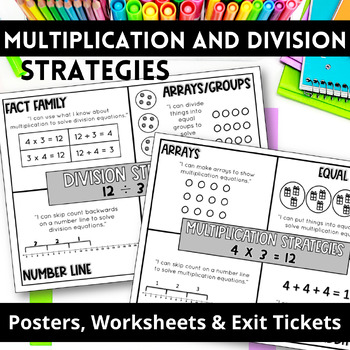Multiplication and Division Strategies Charts, Worksheets and Homework
- Zip
- Easel Activity
What educators are saying
Products in this Bundle (2)
Description
Our students don't all learn in the same way, so let's show them different strategies they can use to solve multiplication and division problems!
These ink-friendly printables will make it easy for you to teach beginner multiplication & division strategies!
This resource was made to address the following Common Core Standards for third grade:
3.OA.1: Interpret products of whole numbers.
3.OA.2: Interpret whole-number quotients of whole numbers.
3.OA.3: Use multiplication and division within 100 to solve word problems in situations involving equal groups, arrays, and measurement quantities
Included in this resource:
Multiplication
Student Anchor Chart: Printer friendly 1-page anchor chart to give to students or display in classroom. Introduces and shows examples of the four strategies for solving multiplication problems:
- Arrays
- Equal Groups
- Number Line
- Repeated Addition
Print & Go Worksheets: For each of the four strategies, there are two practice pages (labeled A and B). Use these pages to reinforce learning as morning work, homework, or in-class work.
Quick Check Worksheets: For each of the four strategies, there is a half-page ‘quick check’ with two questions. This will give you a quick idea of how your students are grasping each strategy!
Also included are two worksheets and a quick check that combine all four strategies. Your students will have to show you four different ways to solve each problem.
Division
Student Anchor Chart: Printer friendly 1-page anchor chart to give to students or display in your classroom. Introduces and shows examples of the four strategies for solving division problems:
- Fact Family
- Arrays/Equal Groups
- Number Line
- Repeated Subtraction
Print & Go Worksheets: For each of the four strategies, there are two practice pages (labeled A and B). Use these pages to reinforce learning as morning work, homework, or in-class work.
Quick Check Worksheets: For each of the four strategies, there is a half-page ‘quick check’ with two questions. This will give you a quick idea of how your students are grasping each strategy!
Also included are two worksheets and a quick check that combine all four strategies. Your students will have to show you four different ways to solve each problem.
Copyright © Cupcakes & Curriculum
Permission to copy for single classroom use only.
Please purchase additional licenses if you intend to share this product.





